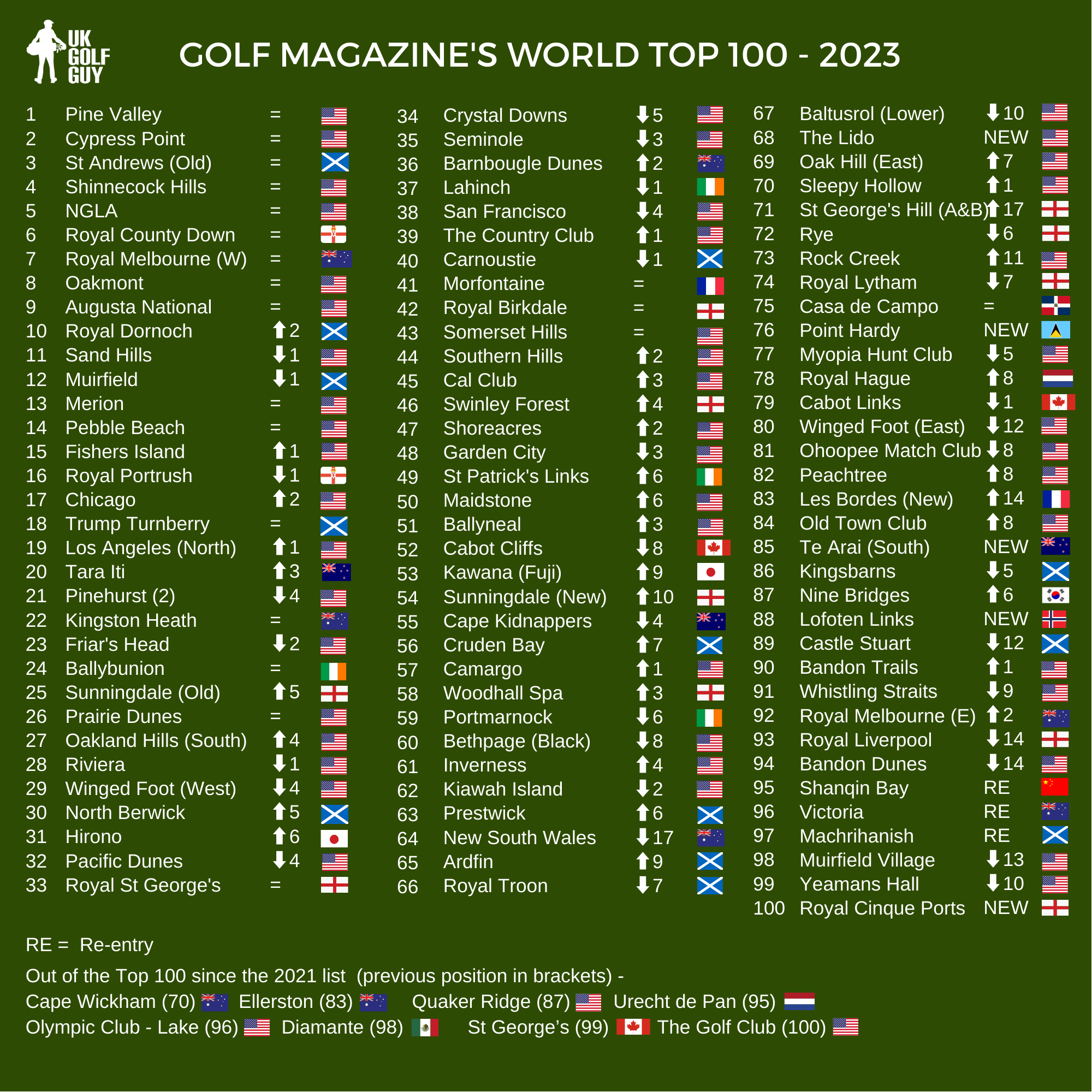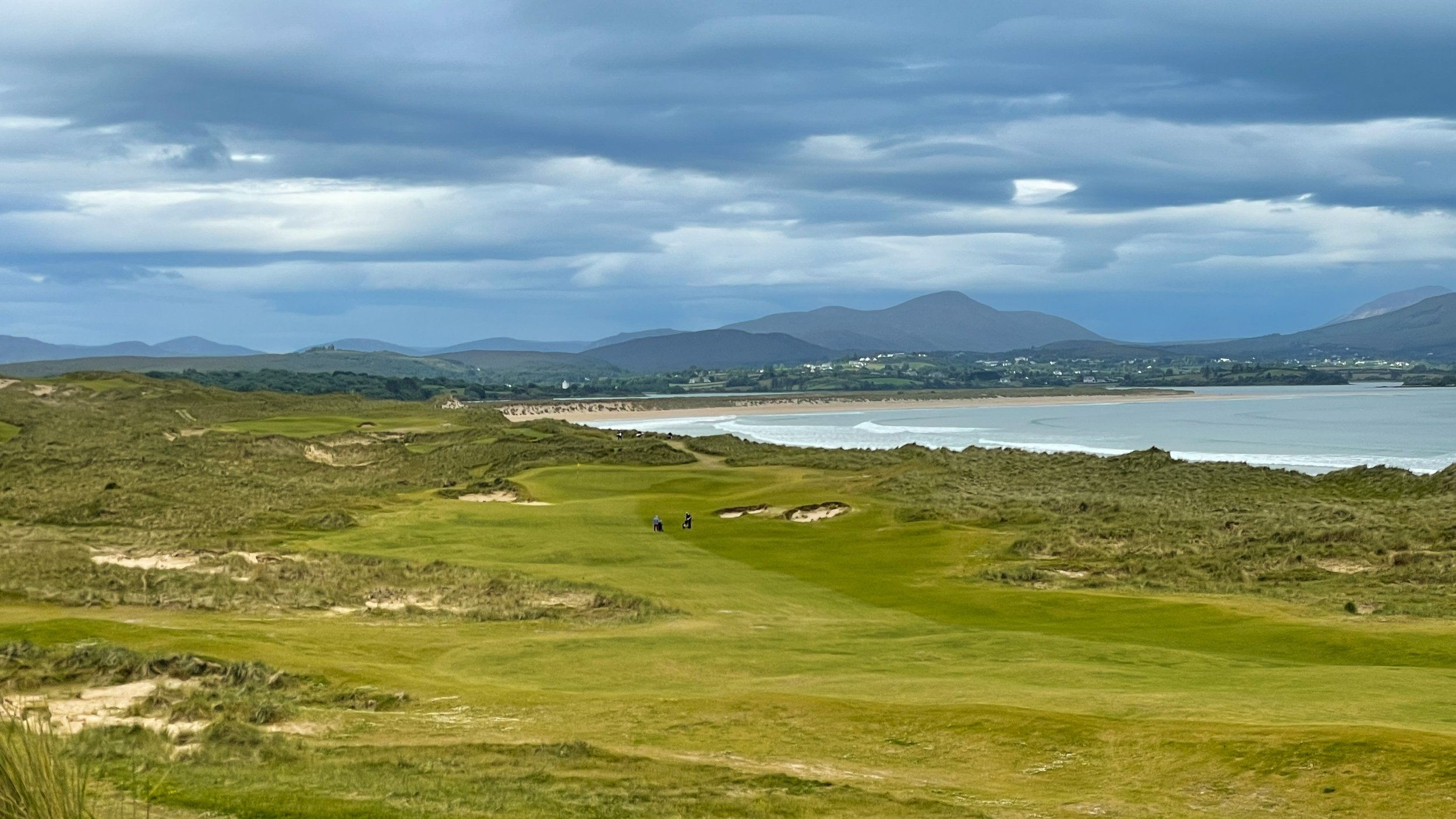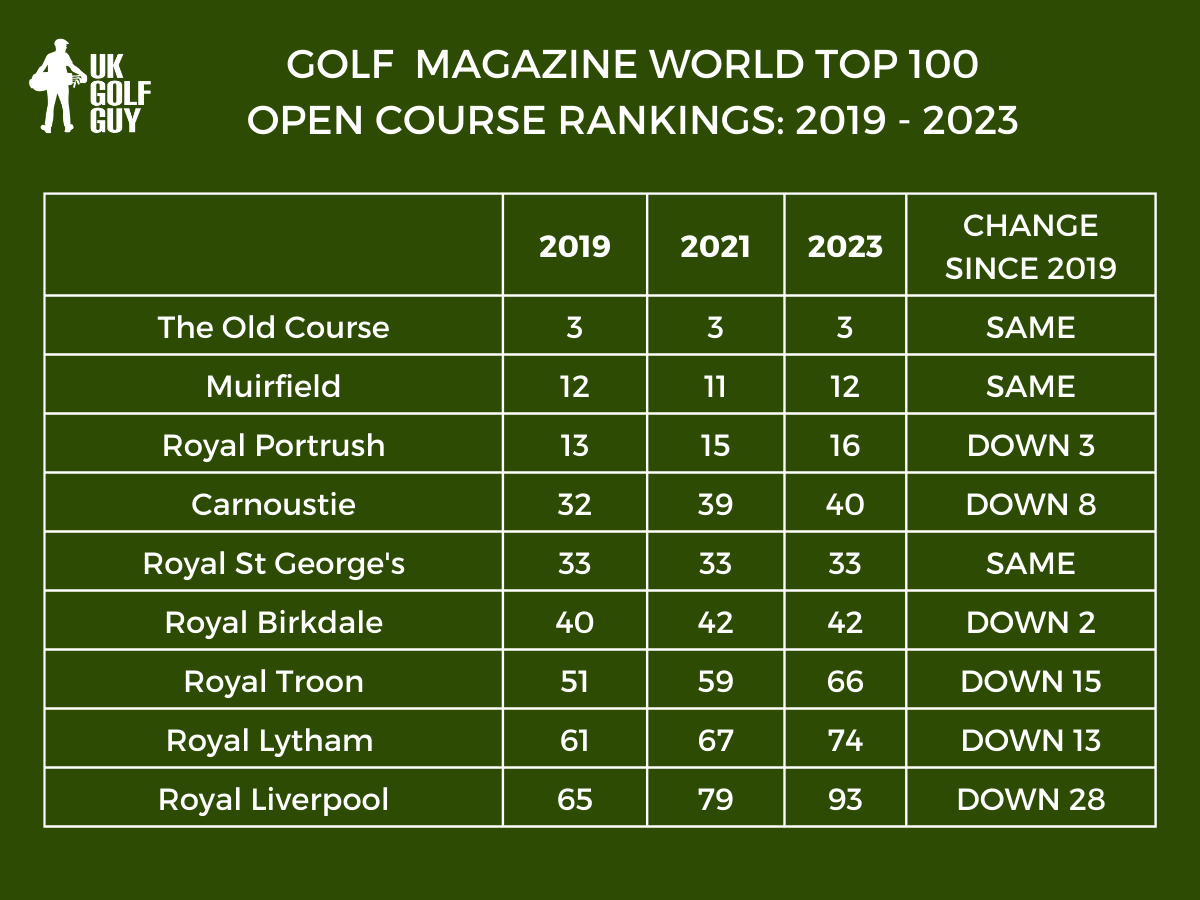Every two years certain sections of the golf world hold their breath as they wait for the US-based GOLF Magazine World Top 100 list to appear.
For some clubs, inclusion on the list will lead to a boost in business and reputation. For some, expulsion will lead to a drop in visitor numbers and hard questions being asked. But for others, normally those that have been around a while longer, it will mean nothing but bragging rights over their friends at the club next door.
And of course, let’s not forget those brave souls trying to play the top 100 courses in the world. The exclusion of a hard-to-access might mean their prospects of completing the list have improved. But if another super-exclusive course has entered the fray it could lead to heartbreak.
At the end of the day, the list is just an aggregation of the views of 115 people who happen to have been chosen by one editor. But it’s fun to have a nitpick!
I’ve included some thoughts below, but if you can’t wait to get to the juicy bit, here’s the 2023 list.
METHODOLOGY
With any golf ranking list there are really only two key things - who is doing the judging and how are the doing it?
Let’s start with the ‘who’. The GOLF website lists the 115 people who sit on the panel. This was last updated in November so there might have been a few changes since then, but the make-up is relatively stable.
Of these 115 people, 85 are based in North America. 6 are in the UK, 5 are in Australia, 4 in Canada and 4 in Ireland. There is then a smattering of representation from elsewhere round the globe. It’s hard to tell from the names alone, but I think that fewer than 10 of the 115 are women.
The panel comprises people with an educated eye and wide experience of golf courses throughout the world. Some do it out of passion, others are in industry. There is healthy representation of the world’s leading course architects, their employees and their clients.
Other US-based rating panels have thousands of members who pay for the privilege of joining - often in the hope of access to courses. GOLF magazine has none of that nonsense. You need to be chosen by a committee including the editor, Ran Morrissett. founder of Golfclubatlas.com and co-contributor to the Confidential Guide. He describes the panel as a group of the people whose opinion he values most.
As for the ‘how’, again, this is a lot simpler than for other rankings. Morrissett describes it thus -
‘For the newly released 2023-24 World list, each panellist was provided a ballot that consisted of 504 courses globally. He or she was given seven months to complete it. Beside the list of courses were 11 “buckets,” or groupings. If our panellists considered a course to be among the top three in the world, they ticked that first column. If they believed the course to be among Nos. 4-10 in the world, they checked the next column, followed by 11-25, 26-50, and so on out to 250+ and even a column for remove.
Points were assigned to each bucket; to arrive at an average score for each course, we divide its aggregate score by the number of votes. From those point tallies, the courses are then ranked accordingly. It is an intentionally simple and straightforward process.’
You can read more about the methodology here.
I really like this way of doing it. Of course, it means that the make-up of the panel is even more important for this ranking than for those where more guidance and criteria are given. But the methodology has consistently produced what is widely considered to be the best listing of the world’s top courses.
DEMOGRAPHICS
Here’s a quick look at the make-up of the 100 courses.
Geography
The US and the UK absolutely dominate the list. Throw in English-speaking Canada, Ireland, Australia and New Zealand and you’ve got 90 of the top 100!
USA - 49
UK -26
Australia - 7
Republic of Ireland - 4
New Zealand, France, Japan, Canada - 2 each
Norway, St Lucia, Dominican Republic, South Korea, Netherlands, China -1 each
Age
70 of the Top 100 courses were built before the Second World War. There is something of an architectural wasteland from that golden age until the turn of the 21st century, before a renaissance in the last twenty odd years.
Access
In a list dominated by US courses it is inevitable that there will be a lot that mere mortals can’t play. There are varying degrees of ‘private’, but put it this way - you can call up 55 of the 100 and get a tee time.
29 of the top 50 courses are in the US and only 3 of those are open to the general public. It’s the American ones which make playing the whole list hard, but the likes of Hirono, Ardfin, Shanqin Bay and Morfontaine aren’t exactly easy to get on either. But it’s a farewell to Ellerston, the bane of many a list chaser due to its increasingly hard access policy. Few tears are being shed around the world today at its absence!
If you are looking for a list of the Top 100 courses in the world you can actually play have a look at this ranking from Today’s Golfer.
THE IRISH BIG FIVE IS NO MORE!
For as long of courses have been rated by GOLF magazine, 5 courses in Ireland - Royal County Down, Royal Portrush, Ballybunion, Lahinch and Portmarnock - have taken the country’s top 5 spots in one order or another. Well St Patrick’s Links at Rosapenna has changed that. It has risen 6 places to 49th and Portmarnock has dropped 6 to 59th. That’s big news in Irish golf!
I am an unashamed fan of St Patrick’s - it may well be the best of Doak’s courses that I have seen, and I suspect the ‘Big 5’ is now the ‘Big 6’ for good!
St Patrick’s Links makes a deserved rise up the rankings.
WE LIVE IN THE DOAK ERA
So, you’ve got a few million dollars burning a hole in your pocket, a wonderful site for a golf course and a desire to build a Top 100 golf course. Who you gonna call?!
Well, if you want to do well in the GOLF Magazine World Top 100, all roads would lead to Tom Doak. Or maybe Coore & Crenshwaw at a push.
Let’s look at some facts.
Doak has built 8 of the top 12 highest-ranked modern courses.
Coore & Crenshaw have 3, Bob Harrison has 1.
Doak has 8 of the 25 modern courses on the whole list. Coore and Crenshaw have 7, Gill Hanse has 3 and then it’s all singles.
Sand Hills (ranked 11th) - Coore & Crenshaw
Tara Iti (20) - Doak
Friar's Head (23) - Coore & Crenshaw
Pacific Dunes (32) - Doak
Barnbougle Dunes (36) - Doak & Clayton
St Patrick's Links (49) - Doak
Ballyneal (51) - Doak
Cabot Cliffs (52) - Coore & Crenshaw
Cape Kidnappers (55) - Doak
Ardfin (65) - Harrison
The Lido (68) - Macdonald and Doak
Rock Creek Cattle Company (73) - Doak
Teeth of the Dog (75) - Dye
Point Hardy (76) - Coore & Crenshaw
Cabot Links (79) - Whitman
Ohoopee Match Club (81) - Hanse
Les Bordes New (83) - Hanse
Te Arai South (85) - Coore & Crenshaw
Kingsbarns (86) - Phillips
Nine Bridges (87) - Fream and Dale
Lofoten Links (88) - Turner
Castle Stuart (89) - Hanse
Bandon Trails (90) - Coore & Crenshaw
Bandon Dunes (94) - McLay Kidd
Shanqin Bay (95) - Coore & Crenshaw
Maybe we are in a catch-22 position? Developers understandably want to give themselves the best chance of commercial success, so they give the jobs to the architects who build the courses that are highest ranked.
You then get into the question of whether these are actually the best architects, or the ones who get the best land or whose designs the raters just like the most?
There is no possible way to answer that. I have seen a fair few of the Doak and C&C courses on this list and have thoroughly enjoyed them. In fact, I could make a case for some of them being ranked too low.
The 7th at Tom Doak’s Barnbougle.
But what could have happened if other architects had got their hands on the same land?
Of course, we’ll never know. But I played Kyle Phillips’ South Cape in South Korea earlier this year. He’s only got one course in the Top 100 list, Kingsbarns, and isn’t as well-known as some of the other architects. South Cape was magnificent and I couldn’t understand why it wasn’t on this list.
Well firstly, it has an owner who isn’t particularly fussed about the rankings. They will welcome raters, but they don’t put on special events for them.
Secondly it never got the buzz from having a big name architect associated with it. One rater told me he had been to South Korea’s only entry, Nine Bridges, four times but had never been to South Cape. How bewildering. How depressing.
Wonderful South Cape - worth a look!
Tom Doak isn’t getting any younger and his associates are taking bigger roles in the development of new courses. But it may be a while before an developer says ‘give me an Iverson, Schneider, Moser or Johnson course’.
Here’s a fact that I bet every developer knows: Doak has never had a course drop out of the Top 100. Expect to see more Doak courses over the next few years.
CLASSIC UK LINKS COURSES DO WELL - WELL, APART FROM THOSE ON THE OPEN ROTA!
It’s been an interesting few years on this list for the UK links courses. Some have done really well. North Berwick, Prestwick, Cruden Bay have all seen significant rises up the list and Royal Cinque Ports has entered the list for the first time. These courses have a little more quirk than others and have largely been unchanged in recent years - no new holes, no re-routings. They may have put in a few extra tees but have otherwise concentrated on the presentation of the courses.
However, courses on the Open rota have suffered in comparison. Here’s what’s happened to them over the last three editions -
So what is going on here? Well part of it is just down to the tastes of the panel. Some of these championship courses are being set up more penally from what I have seen. Fairways are getting tighter, rough is getting thicker and bunkers are deeper. This really doesn’t lend itself to the tastes of the GOLF panel, or indeed the average golfer.
One outlier is Muirfield. It has always had a reputation for a tough set-up, but in recent years the course’s playability has improved significantly, and feedback from visitors has improved too.
Another factor is that the R&A have become more prescriptive about what they require from an Open course these days. The Open is incredibly important financially for The R&A and they are focussed on extracting every pound possible from the event. They talk about what a modern Open requires from a venue. Well, those requirements have been entirely driven by the R&A.
In order to extricate maximum revenue, they demand a lot from a host venue. Flow of people around the course is more important than ever, and space for the ever growing hospitality and concessions stands is required too. They don’t worry too much about the size of the grandstands though. The provision of seats hasn’t grown proportionally with the growth in attendances and some grandstands have actually shrunk - people don’t spend money when they’re sitting down. The R&A want you moving around, spending money!
Courses have also been asked to be more attractive for TV. A new 17th hole, ‘Little Eye’, was put in this year at Hoylake by architecture firm Mackenzie and Ebert. It felt out of keeping with the rest of the course and wasn’t liked by the membership. Do changes like that help courses in the GOLF magazine ranking? I suspect not. Does the R&A care? I suspect not.
‘Little Eye’ at The Open this year.
One leading architect told me that he had no interest in working on Open rota courses as the briefs aren’t written to improve the courses - they are written to improve the R&A’s revenue.
Members of Royal Birkdale and Royal Lytham must be looking on in trepidation as their courses go under the M&E knife.
Ironically, Muirfield is escaping unscathed as the R&A seems to have deemed the site not big enough for an Open any more. The course and membership may be better off for this.
These courses are national treasures and I believe they should be only changed if there are incredibly good, golfing reasons. How naïve I am!
WHATEVER HAPPENED TO LETTING A COURSE FIND ITS FEET?
One of the trends of late is that some new courses make a big splash very quickly. Tom Doak’s Lido opened for play in June and has gone straight in as the 68th best course in the world. The new Cabot course in St Lucia from Coore and Crenshaw can beat that. Pont Hardy comes in at 76 despite not being officially open yet - it’s only had some preview play. Coore and Crenshaw’s course at Te Arai (in at 85) has been open for 12 months now - quite the veteran.
Of course the clubs are delighted to get the publicity, but I think it’s a shame to rush them in. One architect told me that he thought all new courses should have to wait at least two years before being ranked. But in these days of social media clicks and driving eyeballs to websites, that isn’t going to happen.
It does seem that the courses with the biggest PR budget, or best connections, get to the front of the queue. It must be a bit annoying for the likes of Comporta Dunes in Portugal not to have had the raters queuing up. Given time, hopefully they will get there. Although, as you will see further on, they might not.
Having said all of that, The Lido and Pont Hardy look like great additions to the world of golf and I have no doubt they will make many people very happy!
BUT HURRAH FOR LOFOTEN!
Enough quibbling. One course that took a little longer to make the list is Lofoten Links and it’s great to see it make its debut in the Top 100 list. The course is in the north of Norway, well into the Arctic Circle. It doesn’t have a big name architect, but Englishman Jeremy Turner and the owner, Frode Hov, have created something very special here.
It started making an impact on the ranking lists only a couple of years ago when Golf World put it into their Continental Europe Top 100 list. And since then the world has discovered Lofoten Links, they been thrilled by what they have found.
With rumours of Tom Doak’s team visiting with a view to working on the course, and even a possible second 18, the future looks very bright for Lofoten Links.
CAPE WICKHAM - GONE BUT NOT FORGOTTEN
I try to use these articles to find themes, not moan about individual course positions but I just can’t let this one go. Cape Wickham has gone from 70th last time (60th in 2019) to being banished from the list. I think this is insane. There, I’ve got that out of my system.
You can read my review of the course here. And here’s a photo of the wonderful 18th on what Alan Shipnuck called the most visually stunning course in the world.
But Cape Wickham is so much more than just a spectacular setting. The course is pure fun to play from beginning to end. It opens with maybe the best first hole in the world - a thrilling, cliffside par 4 where the tee is a continuation of the practice putting green.
It’s a very playable course. Ardfin and Lofoten have great settings too but both are far more punishing than Cape Wickham. Cape Wickham gives one joy after another.
It’s rated highly elsewhere. The only other comprehensive world list, from top100golfcourses.com, has it at 58 in the world. The Today’s Golfer list of golf courses that you can play (it excludes private courses) has it at number 7. Golf Australia magazine has it as the 2nd best course in the country and Australian Golf Digest has it as number 3.
But the raters of GOLF Magazine clearly don’t agree.
I have spoken to several raters over the years. Some of them have played it and some haven’t. Several went on a trip some years ago when it was very windy. They thought the site unsuitable for a Top 100 golf course.
Ran Morrissett was on the excellent Australian Golf Passport podcast earlier this year (you can hear him talk about Cape Wickham and King Island around the 36 minute mark, on episode 25 which you can fine here.).
Ran sounds incredibly downbeat when talking about Cape Wickham. But this statement really took me aback. He said, ‘The average wind is essentially gale force from every direction. I don’t know of a windier site for a golf course than there. With that kind of wind comes some real restrictions on an architect and that’s a tough problem to handle”.
That’s a hell of a claim, and I can’t find the facts to back it up.
Here’s some data from King Island airport which is just under 30 miles away. Of course, it will be different at the course which is more exposed, but it would have to be going some for Ran to be right. I’ve compared it to Launceston Airport, which is the nearest reading to Barnbougle, by way of comparison.
Now, don’t get me wrong. I’m not saying that it’s not windy there. There’s a 1-2 club wind most of the time. But it’s only over 25mph 1% of the time. To qualify as a gale force wind it needs to get to 30mph.
I know someone who has played there more than twenty times and has never been called off because of the weather.
As you can probably tell, this really bothers me! Ran says, both in his tone and words, that this place isn’t suitable for golf because you’re constantly playing in a gale force wind. That’s just not right.
And it matters. The accepted narrative seems to have become that King Island is too windy for golf. I know of a rater who decided not to go to King Island when visiting Melbourne for this very reason. Wow!
I know people who travel from the other end of the world just to play the course. There are people who have played virtually all of the best courses in the world who have it in their top 10. I would be prepared to bet that if you asked an average golfer to play Cape Wickham, then almost any other Australian course, and then asked them which they preferred, the answer would be Cape Wickham more often than not.
It’s a wonderful, thrilling place to play golf. It exemplifies pretty much everything I love in a golf course.
Cape Wickham is in a precarious position. The transport links aren’t great. The hotel provision on the island isn’t great. But people have come - often because they have heard it is one of the best golf courses in the world.
I fear for its future. Fewer people will go there now because of this listing. Does GOLF magazine have a responsibility for the financial viability of golf courses around the world? Of course not. But I do think it has a responsibility to ensure people have the correct facts.
BUT ENOUGH MOANING….
Thank you for making it this far!
While it might sound like I am moaning a bit, but there really is a lot to like in this list. I think it celebrates wonderful architects and identifies almost all of the best golf courses in the world!
I’ll leave you with a picture I took at the best course in the world. Well, the best according to GOLF Magazine, and who am I to disagree!!








